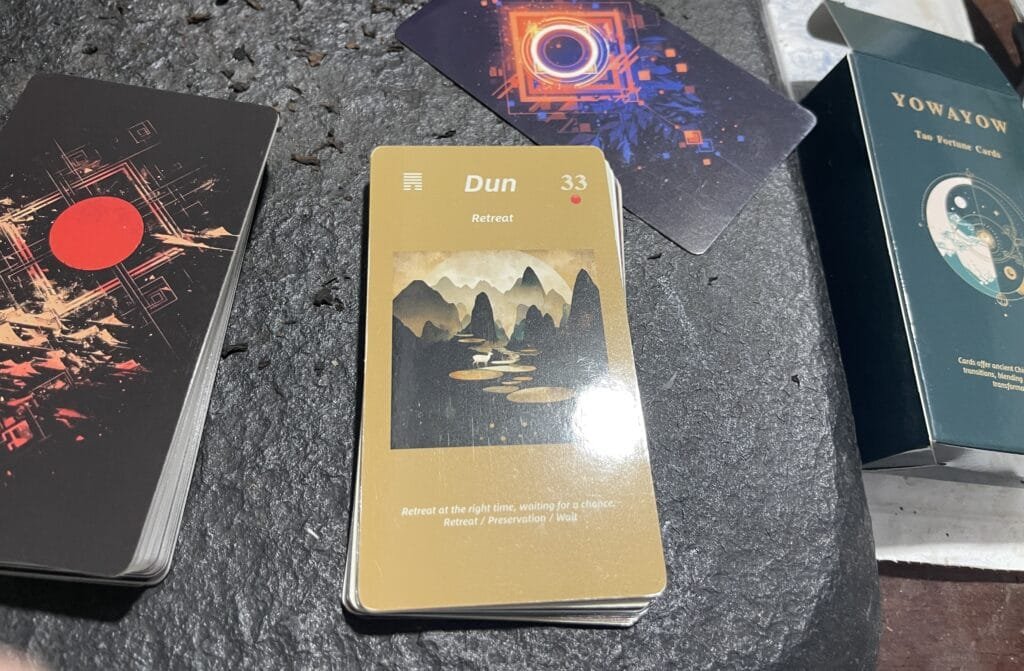The Retreat Hexagram (Dun Gua) in the I Ching, composed of Qian (Heaven ☰) above and Gen (Mountain ☶) below, symbolizes the wisdom of “retreating to advance” when yin energy rises and yang recedes. Projecting this ancient symbol onto the spiritual landscape of the digital age, we find a striking resonance with the psychological dilemmas of contemporary youth—caught between social anxiety and emotional hunger, they turn to AI companionship, online communities, and short-term healing content, forming what we call the “Loneliness Economy.” This phenomenon mirrors the Hexagram’s “art of retreat,” embodying both protective survival wisdom and the risks of excessive indulgence.
I. Hexagram Analysis: The Philosophy of “Retreat” and “Restraint”
The Retreat Hexagram, with Heaven above and Mountain below, depicts a scene where “Heaven stands on a mountain that gradually recedes,” symbolizing proactive withdrawal to maintain dignity. The hexagram statement “Retreat brings progress; minor correctness is beneficial” reveals that moderate withdrawal leads to clarity, but one must uphold balance. Among its six lines:
- Line 1 (Bottom Yin): “Retreating at the tail, peril” warns that excessive or belated withdrawal invites danger.
- Line 4 (Top Yang): “Graceful retreat, auspicious for the noble person” praises deliberate, controlled withdrawal.
- Line 6 (Top Yang): “Liberated retreat, no adversity” describes transcendent detachment beyond utility.This layered philosophy of retreat mirrors how young people seek psychological buffers in the digital world.
II. The Digital “Retreat Landscape”: Three Reflections of the Loneliness Economy
(1) AI Companionship: The Algorithmic “Virtual Mountain”
When Gen Z users create “gentle boyfriend” personas on Replika or confide in “Xiaodu” about academic stress, AI chatbots become their “digital mountains.” Their 24/7 non-judgmental responses align with the compensatory psychology of Line 1—one university student admits, “It’s easier to talk to AI than face real-world judgment.” However, over-reliance risks a “digital cocoon”: Stanford research shows that users of AI companions for over six months experience an 18% decline in real-world empathy, echoing Line 1’s warning “Do not proceed thus.”
(2) Online Communities: Anonymous “Retreat Collectives”
Platforms like Douban’s “Office Worker Survival Guide” (with millions of members) and Xiaohongshu’s “Healing Copywriting” (billions of views) form modern “retreat communities.” These spaces embody Line 2’s metaphor “Bound with yellow ox hide leather”—using rules (group guidelines) to define retreat boundaries, offering non-confrontational psychological protection through anonymity. Users transform emotional energy via “confessional sharing-stranger empathy,” like a dynamic balance of “mountain stillness and river flow”: A young professional who kept a 30-day emotional journal on Douban later told a counselor, “The resonance in the group gave me courage to face real issues.”
(3) Short-Term Healing: Fragmented “Instant Mountains”
15-second “soul-soothing” videos on Douyin and 3-minute psychology lessons on WeChat Reading serve as “instant retreats” in fast-paced life. This aligns with Line 3’s dialectic “Tethered retreat, sickness and peril”—while short-term stimulation boosts oxytocin by 23%, fragmented consumption causes “psychological malnutrition.” A short-video user admits, “I saved 200 healing videos, but feel more anxious at night,” reflecting the Hexagram’s warning: “Bondage to objects prevents true retreat.”
III. Translating Retreat Wisdom into Modern Psychology: From Avoidance to Transcendence
(1) Psychological Adjustment: A Three-Stage Retreat Model
Awareness Stage (Corresponding to Line 4: “Graceful Retreat”): By mapping digital behaviors to the six lines, individuals can identify their retreat patterns. For example, excessive AI use (affecting sleep) signals Line 1’s “tail retreat” needing correction, while controlled community use reflects Line 4’s healthy “conscious retreat.” This self-awareness, akin to ancients using hexagrams for self-reflection, helps modern users recognize their psychological trajectories in digital life.
Practice Stage (Embodying Line 2: “Central Restraint”): Translate the Hexagram’s “stillness” into actionable boundaries—create a “Digital Mountain Boundary,” such as an “AI Sunset Rule” (no use after 10 PM) to reinstate AI as a tool rather than an emotional crutch, or a “Real Social Rehabilitation List” (3 weekly face-to-face interactions) to rebuild authentic connections. This balance embodies the Hexagram’s emphasis on “minor correctness.”
Transcendence Stage (Achieving Line 6: “Liberated Retreat”): Shift from passive avoidance to active cultivation. Practices like “Retreat Meditation”—visualizing an inner mountain as a symbol of stability—help maintain mental focus amid information overload. Embrace “selective retreat”—voluntary detachment not as escape but as preparation, achieving what Chuang Tzu called “inner seclusion” (spiritual retreat in simplicity). This transcendence, described in Line 6, is not forced escape but conscious mental space.
IV. Hexagram Wisdom in Reality: Rebirth Through Retreat
The ultimate lesson of the Retreat Hexagram is “Retreat is not final; it bides time for renewal.” When Gen Z practices empathy through AI, accumulates mental strength in communities, and gains courage from short-term healing, these “retreats” transform into self-healing strategies. As Line 6 suggests, true psychological freedom begins with understanding retreat not as cowardice, but as creating a “mountain stillness” buffer for the heart, allowing life energy to regenerate in balance.
In this era of information overload and superficial social interaction, the Retreat Hexagram offers a timeless reminder: AI is a training ground for dialogue, not an emotional greenhouse; communities are rest stops, not permanent shelters; healing content is fuel, not the destination. True healing lies in the rationality of “graceful retreat,” the discipline of “central restraint,” and the freedom of “liberated retreat”—a 3,000-year-old gift guiding us to anchor the self amid digital waves.
